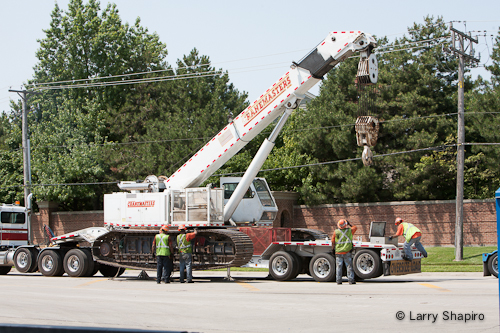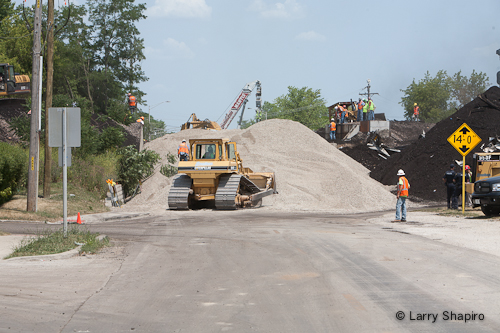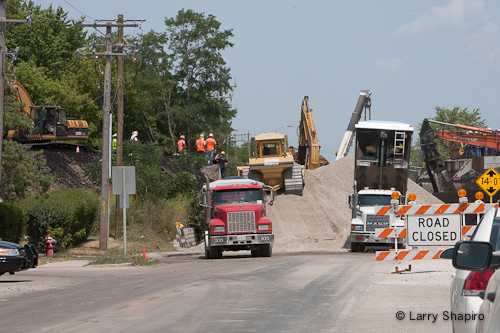
A heavy-lift crane is loaded onto a lowboy at the crash site. Larry Shapiro photo
As railroad and construction workers cleared the debris from the collapsed bridge over Shermer Road, they discovered a car that was buried underneath the rubble. Glenview firefighters have been at the scene today working to gain access to the car.

Work as seen from the south side of the Shermer Road bridge as gravel is built up to the level of the tracks. Larry Shapiro photo

A steady stream of large dump trucks brings gravel to the site of the destroyed bridge to build a temporary base so that train traffic can resume soon. Larry Shapiro photo
Firegeezer.com filed the following report:
Update, 3 pm Thursday:
Cleanup crews discovered an automobile with one body inside underneath the bridge debris Thursday morning.
Also, the railroad inspectors have determined what caused the bridge to fail. Both discoveries are covered in this Chicago Tribune report:
Officials initially said no one was injured when the train hauling coal derailed on Union Pacific tracks near Willow Road and Shermer Avenue around 1:45 p.m. Wednesday. But this morning, crews spotted the bumper of a car and dug around it with shovels, officials said.
Shortly before 1 p.m., workers could be seen clearing off what appeared to be the windshield, then covering the area with a blue tarp. Officials on the scene said one body was inside, and they were working to remove it.
WGN-TV
* * *
While the investigation of the derailment continues, extreme heat causing steel rails to expand is a possible cause of the derailment and subsequent bridge collapse, a Union Pacific Railroad spokesman said Thursday.
The preliminary investigation has ruled out the failure of the bridge as the trigger to the accident, said UP spokesman Mark Davis. The bridge was not designed to carry the load of 28 coal cars that derailed, each weighing 75 tons to 85 tons, on the 86-foot bridge, Davis said.
Davis confirmed that UP inspectors were on the tracks checking for possible abnormalities in track gauge or shifting before the accident. Such inspections are routinely conducted twice a day during extreme heat or cold, he said.
Because of the “heat order,” a 40 mph slow zone order, down from 50 mph normally on that segment of track, was in effect at the time of the accident, Davis said. An event recorder in the locomotive showed that the train was traveling at 37 mph when it derailed, he said.
“We ruled out the bridge failing and then the train derailing, based on the discussion with the train crew’’ as well as viewing the images from a camera on the train, Davis said. “The derailment occurred and then what happened was that 28 cars piled onto the bridge structure. Under all that weight, the bridge went down.’’
Since that report was posted, the medical examiner arrived on the scene and the body was then removed. Any personal information of the victim including its sex has not been released. The railroad authorities have stated that there is still a possibility that they may find more victims under the debris.






























